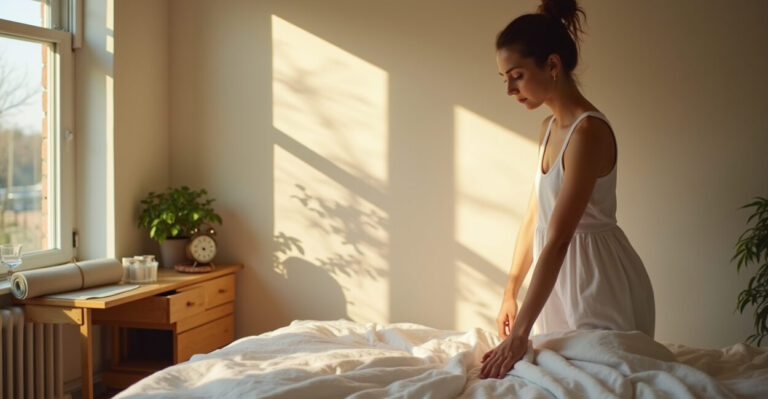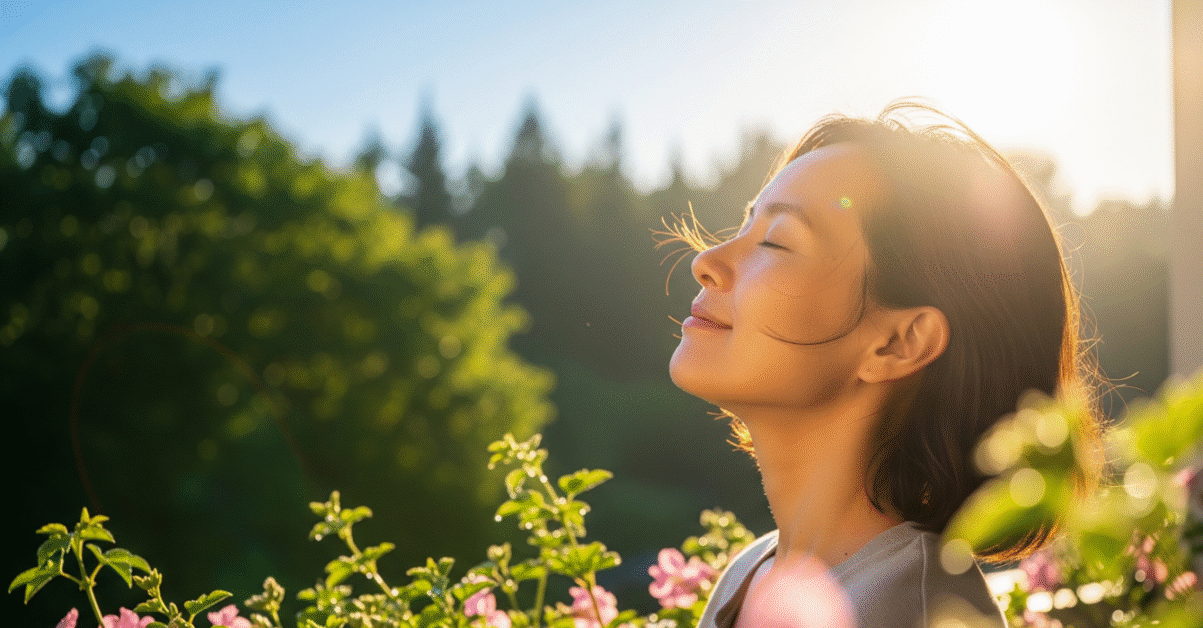Warning: Cannot modify header information - headers already sent in /home/u278635817/domains/mymorninglife.com/public_html/wp-content/plugins/artigosgpt/artigosgpt.php on line 28215
Warning: Cannot modify header information - headers already sent in /home/u278635817/domains/mymorninglife.com/public_html/wp-content/plugins/artigosgpt/artigosgpt.php on line 28215
Morning sunlight benefits go far beyond a simple aesthetic pleasure; they play a vital role in enhancing our physical and mental well-being. Exposure to natural light early in the day helps regulate our internal clocks, boosts mood, and energizes us for the day ahead. Understanding these benefits can transform how you approach your daily routine and improve your overall health.
In today’s digital era, many of us spend the majority of our time indoors, under artificial lighting, disconnected from the natural cycles that our bodies depend on. This disconnection can lead to sleep disturbances, low energy, and even mood disorders. However, integrating morning sunlight into your life can realign your body’s rhythms and provide a host of health advantages.
This article explores the science behind morning sunlight benefits, detailing how early light exposure influences our biology, mental health, and longevity. We’ll also offer practical guidance on how to maximize these benefits every day.
Contents
ToggleUnderstanding the Impact of Morning Sunlight on Health
How Morning Sunlight Regulates the Circadian Rhythm
The circadian rhythm is our body’s natural 24-hour clock regulating sleep, hormone release, and metabolism. Morning sunlight acts as a powerful cue that resets this internal clock daily. When light hits the retina, it signals the brain’s suprachiasmatic nucleus to suppress melatonin production, the hormone responsible for inducing sleepiness.
This suppression helps you wake up feeling alert and sets the timing for when melatonin will be produced again in the evening, leading to better sleep quality. Without consistent morning light exposure, your circadian rhythm can shift, causing irregular sleep patterns and fatigue.
By syncing your internal clock with natural daylight, morning sunlight benefits extend to improved focus, energy levels, and overall health.
The Role of Vitamin D Synthesis in Wellbeing
One of the most well-known advantages of morning sunlight is its role in stimulating vitamin D production in the skin. Vitamin D is crucial for bone health, immune function, and reducing inflammation. Early sunlight provides UVB rays needed for this synthesis without the intense risks associated with midday sun.
Regular exposure to morning light helps maintain optimal vitamin D levels, which has been linked to lower risks of chronic diseases like osteoporosis, cardiovascular issues, and some cancers. It also supports mental health by contributing to serotonin production.
Incorporating daily sunlight exposure, especially in the morning, is a natural and effective way to enhance your vitamin D status.
Mood Enhancement and Mental Clarity Through Morning Light
Exposure to morning sunlight triggers the release of serotonin, a neurotransmitter that stabilizes mood and promotes feelings of happiness and calm. This effect can reduce symptoms of depression and anxiety, particularly in people susceptible to Seasonal Affective Disorder (SAD).
Additionally, natural light exposure improves cognitive function and alertness, helping you think more clearly and stay focused throughout the day. This mood-boosting effect is one of the most immediate and noticeable morning sunlight benefits.
Spending time outside or near a window during early hours can make a significant difference in emotional well-being and productivity.
- Step 1: Wake Up Early – Aim to rise with or shortly after sunrise to catch the freshest natural light.
- Step 2: Spend Time Outside – Get at least 15 minutes of direct sunlight exposure, preferably without sunglasses, to maximize benefits.
- Step 3: Avoid Artificial Light – Limit screen time and bright indoor lighting before and during your morning routine.
- Step 4: Incorporate Morning Walks – Engage in light physical activity outdoors to boost circulation and mood.
- Step 5: Maintain Consistency – Make morning sunlight exposure a daily habit for lasting health improvements.
How Early Daylight Influences Sleep Quality and Patterns
Morning Sunlight’s Effect on Melatonin Production
Melatonin is the hormone responsible for making you feel sleepy, and its production is tightly controlled by light exposure. Morning sunlight suppresses melatonin, helping your body transition naturally from rest to wakefulness. This process ensures melatonin peaks only at night, facilitating deep, restorative sleep.
Disrupted melatonin rhythms often cause insomnia and daytime drowsiness. Regular morning light exposure helps recalibrate this system, improving sleep onset and duration.
Consistent exposure to early sunlight is essential for reinforcing healthy sleep-wake cycles.
Link Between Morning Light and Sleep Disorders
Lack of morning sunlight is a common factor in conditions like delayed sleep phase syndrome and insomnia. Without natural light cues, the body’s internal clock may drift, leading to difficulty falling asleep or waking up at desired times.
Studies show that people who receive regular morning sunlight experience fewer sleep disturbances and report higher sleep satisfaction. This is especially important for shift workers or those living in northern latitudes where daylight hours fluctuate seasonally.
Using morning sunlight exposure as a non-pharmacological approach can be a powerful tool to combat sleep disorders.
Enhancing Sleep Hygiene with Natural Light
Incorporating morning sunlight into a broader sleep hygiene routine enhances its effectiveness. This includes dimming lights at night, setting regular sleep schedules, and limiting caffeine or heavy meals before bedtime.
Natural light exposure anchors your circadian rhythm, making it easier to implement these habits and enjoy restful sleep.
Optimizing your environment with morning sunlight benefits your sleep quality and daily alertness.
| Sleep Factor | Effect of Morning Sunlight | Result on Health |
|---|---|---|
| Melatonin Regulation | Suppression in the morning, production at night | Improved sleep onset and depth |
| Circadian Alignment | Reset of internal clock | Consistent sleep-wake cycles |
| Sleep Disorders | Reduction in symptoms | Better overall sleep quality |
Boosting Immune Function with Early Sun Exposure
Vitamin D’s Crucial Role in Immunity
Vitamin D produced through morning sunlight plays a pivotal role in enhancing immune responses. It activates immune cells that protect against infections and modulates inflammation to prevent chronic disease.
Deficiencies in vitamin D have been linked to increased susceptibility to respiratory infections, autoimmune diseases, and slower recovery times.
Consistent morning sunlight exposure ensures your body maintains adequate vitamin D levels to support a robust immune system.
Morning Sunlight and Inflammation Reduction
Chronic inflammation underlies many health issues, including heart disease, diabetes, and arthritis. Morning sunlight helps lower inflammatory markers by promoting vitamin D synthesis and regulating immune cell activity.
This anti-inflammatory effect contributes to improved cardiovascular health and metabolic function. It also supports faster healing and less pain in chronic conditions.
Integrating morning light into daily habits can be a natural way to keep inflammation in check.
Sunlight-Induced Production of Other Immune Modulators
Besides vitamin D, exposure to morning sunlight triggers the production of nitric oxide and serotonin, both linked to immune regulation. Nitric oxide improves blood flow and supports cellular defenses, while serotonin influences mood and stress, which indirectly affect immune function.
These biochemical pathways highlight the multifaceted benefits of morning sunlight on immune health.
- Step 1: Expose Skin Safely – Aim for 10-15 minutes of sunlight on arms and legs without sunscreen during early morning hours.
- Step 2: Balance Exposure – Avoid prolonged sun exposure to reduce skin damage risk while maximizing immune benefits.
- Step 3: Combine with Healthy Lifestyle – Support immune health with balanced nutrition, hydration, and stress management.
- Step 4: Consult Healthcare Providers – If you have skin conditions or immune disorders, seek personalized sunlight exposure advice.
Morning Sunlight as a Natural Energy Booster
How Light Influences Hormones That Control Energy
Exposure to morning sunlight stimulates the release of cortisol, a hormone that increases alertness and energy levels. Cortisol peaks naturally in the early morning, helping you feel awake and ready to tackle daily tasks.
Without sufficient morning light, cortisol rhythms can become disrupted, leading to fatigue and sluggishness.
Harnessing morning sunlight benefits allows your body to optimize hormone cycles related to energy and stress management.
The Connection Between Morning Light and Physical Performance
Research indicates that individuals exposed to natural light in the morning perform better in physical activities. The combination of improved mood, hormone balance, and vitamin D status contributes to enhanced strength, endurance, and coordination.
This makes morning sunlight an excellent companion to exercise routines or active lifestyles.
Regular sunlight exposure can therefore improve both mental and physical aspects of energy.
Incorporating Morning Sunlight into Your Routine for Sustained Energy
Simple lifestyle changes, like opening curtains immediately after waking or taking a brisk outdoor walk, can boost your energy through morning sunlight exposure. Combining light with hydration and balanced nutrition maximizes these effects.
Making morning sunlight a daily habit can reduce dependence on stimulants like caffeine and improve natural energy flow.
| Factor | Benefit from Morning Sunlight | Impact on Energy |
|---|---|---|
| Cortisol Regulation | Morning peak synchronization | Increased alertness |
| Vitamin D Levels | Enhanced synthesis | Improved muscle function |
| Mood Stabilizers | Serotonin release | Boosted motivation |
Strategies to Maximize Morning Sunlight Benefits
Ideal Timing and Duration of Exposure
The best time for morning sunlight exposure is within the first two hours after sunrise. Aim for at least 15-30 minutes daily, depending on skin type and location. Early morning light is less intense and provides optimal UVB rays for vitamin D synthesis without significant risk of sunburn.
Adjust exposure duration seasonally and according to your skin sensitivity to maintain a safe balance.
Consistency is key to reaping long-term morning sunlight benefits.
Creating Sunlight-Friendly Habits
Incorporate sunlight into your morning routine by eating breakfast near a window, taking short outdoor breaks, or exercising outdoors. Avoid sunglasses during these periods to allow maximum light to reach your eyes, which is crucial for circadian regulation.
Reducing screen time and artificial light exposure before and during morning hours enhances natural light’s positive effects.
These small changes can lead to significant improvements in energy, mood, and sleep.
Overcoming Barriers to Morning Sunlight Exposure
Urban living, work schedules, and weather conditions can limit access to natural morning light. To counteract this, consider light therapy lamps designed to mimic natural sunlight, especially during winter months or in northern climates.
Wearing light-colored, breathable clothing and finding green spaces nearby can make outdoor exposure more comfortable and appealing.
Planning ahead and prioritizing morning sunlight exposure ensures you don’t miss out on its health benefits.
- Plan Your Morning Outdoors – Schedule time for sunlight exposure during your daily routine.
- Use Light Therapy Devices – Supplement natural light when unavailable, especially in winter.
- Modify Indoor Spaces – Maximize window access and use reflective surfaces to increase light indoors.
- Stay Consistent – Make morning sunlight exposure a non-negotiable daily habit.
- Protect Skin as Needed – Use sunscreen or cover up after initial exposure to prevent damage.
Long-Term Health Advantages of Morning Sunlight
Reducing Risk of Chronic Diseases
Regular exposure to morning sunlight has been associated with lower risks of conditions such as hypertension, diabetes, and certain cancers. These benefits are largely attributed to improved circadian rhythms, vitamin D levels, and reduced inflammation.
Maintaining a habit of morning light exposure supports cardiovascular health and metabolic balance.
Integrating morning sunlight benefits into your lifestyle is a proactive step toward disease prevention.
Enhancing Longevity and Quality of Life
By improving sleep, mood, immune function, and energy, morning sunlight contributes to a higher quality of life and potentially increased lifespan. Its role in regulating critical biological processes helps reduce the burden of age-related ailments.
Many studies link consistent natural light exposure to better mental health and physical resilience in older adults.
Prioritizing morning sunlight is an investment in long-term vitality.
Promoting Mental Health and Emotional Balance
Morning sunlight’s influence on serotonin and cortisol balances mood and stress responses. This can decrease anxiety, depression, and mood swings, fostering emotional stability and resilience.
Regular exposure also supports cognitive function and memory, which are essential for mental well-being.
Morning sunlight benefits mental health by nurturing a positive and balanced psychological state.
| Health Aspect | Morning Sunlight Benefit | Long-Term Outcome |
|---|---|---|
| Cardiovascular Health | Blood pressure regulation | Reduced heart disease risk |
| Mental Health | Serotonin stabilization | Lower depression rates |
| Immune Defense | Vitamin D synthesis | Fewer infections |
Conclusion
Morning sunlight benefits extend across multiple facets of health, from regulating sleep cycles and boosting mood to enhancing immune function and reducing chronic disease risk. Embracing early daylight exposure can fundamentally improve your energy levels, mental clarity, and long-term well-being.
By making morning sunlight a consistent part of your routine, you unlock natural, effective health advantages that support a balanced and vibrant life. Start today by stepping outside with the sunrise and feel the transformative power of morning light.
Frequently Asked Questions
How long should I spend in the morning sun to gain health benefits?
A daily exposure of 15 to 30 minutes in the early morning is typically sufficient to experience the benefits of morning sunlight. This duration varies based on skin type, geographic location, and season but is enough to regulate circadian rhythms and stimulate vitamin D production safely.
Can morning sunlight help with sleep problems?
Yes, morning sunlight plays a key role in resetting the body’s internal clock, improving melatonin regulation, and enhancing sleep quality. Consistent exposure helps reduce insomnia symptoms and promotes a natural sleep-wake cycle.
Is it safe to get sunlight early in the morning without sunscreen?
Generally, short periods (10-15 minutes) of early morning sunlight without sunscreen are safe for most skin types and beneficial for vitamin D synthesis. However, extended exposure should be protected to avoid skin damage.
What if I live in a place with limited sunlight during winter?
In areas with low winter sunlight, light therapy lamps that mimic natural sunlight can be effective substitutes. They help maintain circadian rhythm and mood when natural light exposure is insufficient.
Does morning sunlight affect mental health?
Absolutely. Morning sunlight increases serotonin production, which improves mood and reduces anxiety and depression. This natural light exposure is especially helpful for people with Seasonal Affective Disorder (SAD).
For further reading and authoritative research on morning sunlight benefits, visit National Institute of Child Health and Human Development and PubMed Central.
More Articles






















